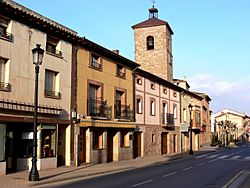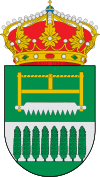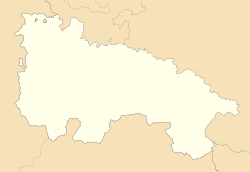Badarán facts for kids
Quick facts for kids
Badarán
|
||
|---|---|---|
|
Municipality
|
||

Badarán's town centre
|
||
|
||
| Country | ||
| Autonomous community | ||
| Province | ||
| Region | Rioja Alta | |
| Comarca | Nájera | |
| Area | ||
| • Total | 20.69 km2 (7.99 sq mi) | |
| Elevation | 623 m (2,044 ft) | |
| Population
(2018)
|
||
| • Total | 502 | |
| Postal code |
26310
|
|
| Website | City Council | |
Badarán is a charming village located in La Rioja, a special region in Spain. It's like a small town that manages its own area. In 2011, about 595 people lived here. The whole area of Badarán is about 20.69 square kilometers, which is roughly the size of 2,069 football fields!
The mayor of Badarán is Francisco Javier Ibáñez Rodríguez. He is part of the PSOE political party.
Contents
A Look at Badarán's Past
People have lived in the Badarán area for a very long time. Scientists have found old remains from the Stone Age, also known as the Palaeolithic period. This was when early humans used stone tools. Later, people also lived here during the time of the Romans.
The village of Badarán started on an important road. This road connected the Monastery of San Millán de la Cogolla with another town called Nájera.
What Does the Name "Badarán" Mean?
The name Badarán comes from the Basque language. Experts say it is made of two words:
- Bad means 'one' or 'first'.
- Aran means 'valley'.
So, Badarán means 'the first in the valley'. This name makes sense because the village is located at the beginning of the Cárdenas River valley.
How Badarán Became One Village
The first time Badarán was written about was in the 900s. It was mentioned in a gift document to the Monastery of San Millán.
Long ago, there were three other small villages near Badarán. Their names were Villagonzalo, Terrero, and Villorquite. On May 15, 1326, these four places decided to join together. This is how the Badarán we know today was formed. The Abbot of San Millán, Diego Lopez, asked King Alfonso XI of Castile for permission to unite them. The King agreed in a city called Burgos.
How Many People Live Here?
The number of people living in Badarán changes over time. In 2010, the population grew to 626 people. This included 330 men and 296 women.
The chart below shows how the population of Badarán has changed over many years.
| Vertical bar chart demographic of Badarán between 1857 and 2010 |
|
EasyTimeline 1.90
|
| Legal population (1857-1897) according to the population census published by the Instituto Nacional de Estadística in the 19th century.
Legal population (1900-1991) or Resident population (2001) according to the population census published by the Instituto Nacional de Estadística. Population according to the municipal register of 2010 published by the Instituto Nacional de Estadística. |
See also
 In Spanish: Badarán para niños
In Spanish: Badarán para niños





